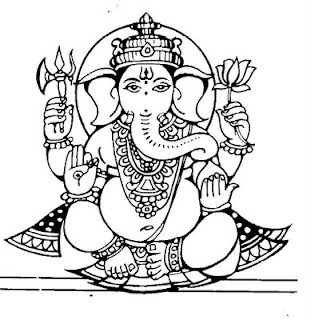Ever since I can remember , I have been a fan of this beautiful idol. Even before I reached an age when I could understand religion and worship, I have been fond of Ganesh idols. One of my many hobbies is collecting these idols. I never miss a chance to grab one and place in my ever-growing collection that I have at home, back in India. This is one of the many things I miss about being in India.
Though there are stories in Indian mythology that explain how a human body was fitted with an elephant head and how he got a God like stature, I am still mystified as to how this beautiful form came about.
Ganesha's iconography has many forms and each form show distinct characteristics of the deity. Some show him lying down, whereas some show him in the dancing pose. Many versions show him with four hands, each hand holding a different object. In all the versions the elephant head, the pot belly and the broken tusk remain common. The slight slant of his eyes are also depicted in most forms.
The Ganesha symbol is a very common symbol in Indian art and hence it finds many variations. The symbol has found changes in due course of time and now a days we find Ganesh drawn as a silhouette with the trunk, large ears, tusk and belly intact, the features that make this icon so unique. There was also this picture of Ganesha made out of two leaves and a hibiscus petal, which I had seen in a restaurant, that stands out.
As a deity Ganesha is considered as a remover of obstacles and is one of the most worshipped Gods in Hinduism. This Deity is not only worshipped in Hinduism but devotion to this God is also found in Jainism and Buddism. He is worshipped across India and ouside India as well. On our trip to Thailand, we were surprised to see a wide variety of art inspired by the Ganesh iconography.
It is the chubby-ness and the cuddly-ness of these idols that attract me to them. Also the various forms in which the idol can be found. I have found that no two idols are the same, since the love and devotion of the person making these idols show in the final outcome. Eagerly waiting to get back to India to resume the collection.
Sadly, I do not have any photographs of my collection to share! That is one of the things I need to do on my next trip to India, get a good snap of my collection :)
Though there are stories in Indian mythology that explain how a human body was fitted with an elephant head and how he got a God like stature, I am still mystified as to how this beautiful form came about.
Ganesha's iconography has many forms and each form show distinct characteristics of the deity. Some show him lying down, whereas some show him in the dancing pose. Many versions show him with four hands, each hand holding a different object. In all the versions the elephant head, the pot belly and the broken tusk remain common. The slight slant of his eyes are also depicted in most forms.
The Ganesha symbol is a very common symbol in Indian art and hence it finds many variations. The symbol has found changes in due course of time and now a days we find Ganesh drawn as a silhouette with the trunk, large ears, tusk and belly intact, the features that make this icon so unique. There was also this picture of Ganesha made out of two leaves and a hibiscus petal, which I had seen in a restaurant, that stands out.
As a deity Ganesha is considered as a remover of obstacles and is one of the most worshipped Gods in Hinduism. This Deity is not only worshipped in Hinduism but devotion to this God is also found in Jainism and Buddism. He is worshipped across India and ouside India as well. On our trip to Thailand, we were surprised to see a wide variety of art inspired by the Ganesh iconography.
It is the chubby-ness and the cuddly-ness of these idols that attract me to them. Also the various forms in which the idol can be found. I have found that no two idols are the same, since the love and devotion of the person making these idols show in the final outcome. Eagerly waiting to get back to India to resume the collection.
Sadly, I do not have any photographs of my collection to share! That is one of the things I need to do on my next trip to India, get a good snap of my collection :)

No comments:
Post a Comment